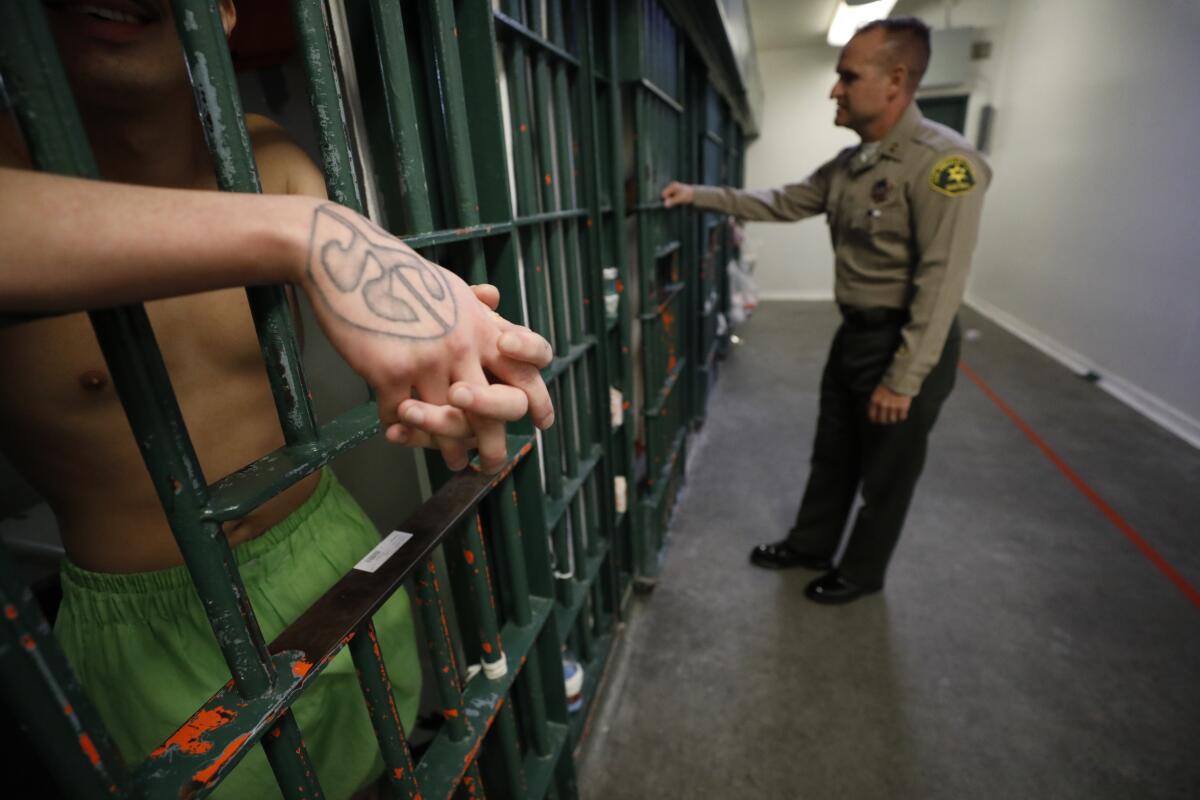L.A. County seeks plan to close aging Men’s Central Jail in a year

Only a year ago, L.A. County leaders scrapped a plan to replace the decrepit Men’s Central Jail, where thousands of inmates are held in cramped cells along narrow hallways in downtown L.A.
Now, the Board of Supervisors is looking at what it would take to close the 57-year-old lockup all together — with no replacement — as they focus on treating the mental health needs of the thousands of people who come in and out of the jail system, which is run by the Los Angeles County Sheriff’s Department and is the biggest such system in the nation.
Officials are also seeking to leverage a reduction in the jail population in recent months driven by the COVID-19 pandemic and the risk of large-scale outbreaks of the disease in cramped quarters.
The move also comes amid a national reassessment of the criminal justice system spurred by the killing of George Floyd in Minneapolis police custody. Civic leaders across the nation are taking hard looks at defunding law enforcement agencies and diverting some of that money to mental health, housing and other community needs.
The county’s focus on finding alternatives to incarceration began well before the recent protests over police brutality.
“We must reduce our reliance just on caging people,” said Supervisor Sheila Kuehl. “The closure of MCJ, as we continue to do that, won’t be the revolutionary concept it looked like today. It’ll simply be logical. It’ll be fiscally prudent and another opportunity for community healing.”
Supervisor Hilda Solis said she sees closing Men’s Central Jail as part of a sea change that will require the county’s criminal justice system as a whole to focus much of its attention on restorative justice.
“I think sometimes when you’re in a crisis, that’s when you have a chance to really change and pivot and go in a different direction, and the direction here is — people want to be treated fairly and equitably,” Solis said.
Officials said they are not revving up the bulldozers just yet.
The board on Tuesday endorsed developing a course of action to close Men’s Central, the largest of seven facilities in L.A. County’s sprawling and overcrowded jail system, within a year. That includes looking at where the inmates held there now would go, how the county’s six other jails would be impacted and the potential cost-savings of such a move.
Any plans to tear down the jail would come with a ramped up Office of Diversion and Reentry, a team created five years ago to help inmates with mental illness or substance abuse problems find housing and support services. Officials pointed to a January study conducted by the nonprofit research agency Rand Corp., which found that more than 60% of the inmates with a mental illness in county jails would be eligible for diversion if there were more facilities capable of providing supportive care.
That means thousands of inmates could be taken out of the criminal justice system, which could save the county hundreds of dollars it costs daily to house each person behind bars. For many, officials said at the time, it would also end a cycle of arrest, homelessness and recidivism.
Since the pandemic began, the Sheriff’s Department has reduced the jail population by about 5,000 — from roughly 17,000 inmates to about 12,000 — to ease overcrowding and avert deadly outbreaks. It marks the first time in at least 15 years that the jail population has dipped below the 12,404-inmate capacity set by the California Board of State and Community Corrections, even though crime has dropped significantly during that same period, according to county officials.
Sheriff Alex Villanueva said Tuesday that only the most dangerous offenders are left behind bars and suggested the closure of Men’s Central Jail would lead to their release.
“The jail system today houses 1,199 murder suspects, 762 attempted murder suspects, 65 manslaughter suspects, 105 rape suspects, 391 child molestation suspects, 1,200 robbery suspects, 142 carjacking suspects, 743 domestic violence suspects,” Villanueva told the supervisors. “Now, you tell me how safe you think you’re going to be with them out there in the community.”
The plan, however, does not call for broad scale releases of violent offenders.
“On any given day there are over 3,000 individuals with mental illness in our jail system who could be safely diverted,” said Supervisor Janice Hahn. “We’re not closing it without a plan, it’s not our desire to release violent criminals into the streets, thus victimizing more people. This is a question we’ve all been asking: Can we demolish this antiquated and unsafe facility with another plan in place?”
Lex Steppling, director of campaigns and policy for Dignity and Power Now who worked with other advocates to help come up with a list of alternatives to incarceration recommended to the board, said Villanueva’s remarks amounted to fear-mongering.
“We have an opportunity to take a much more comprehensive approach to public safety,” he said.
Ron Hernandez, president of the Assn. for Los Angeles Deputy Sheriffs, told the supervisors that Men’s Central was outdated but said he opposed its closure without a suitable replacement.
The board requested a report back from the Sheriff’s Department and the Office of Diversion and Reentry in 60 days.
The motion, authored by Solis and co-authored by Kuehl, said closing the jail would eventually help to address budget shortfalls within the Sheriff’s Department. Due to the economic slowdown caused by the pandemic, officials cut $162 million this fiscal year from the department’s budget.
Times staff writer Jaclyn Cosgrove contributed to this report.
More to Read
Sign up for Essential California
The most important California stories and recommendations in your inbox every morning.
You may occasionally receive promotional content from the Los Angeles Times.











